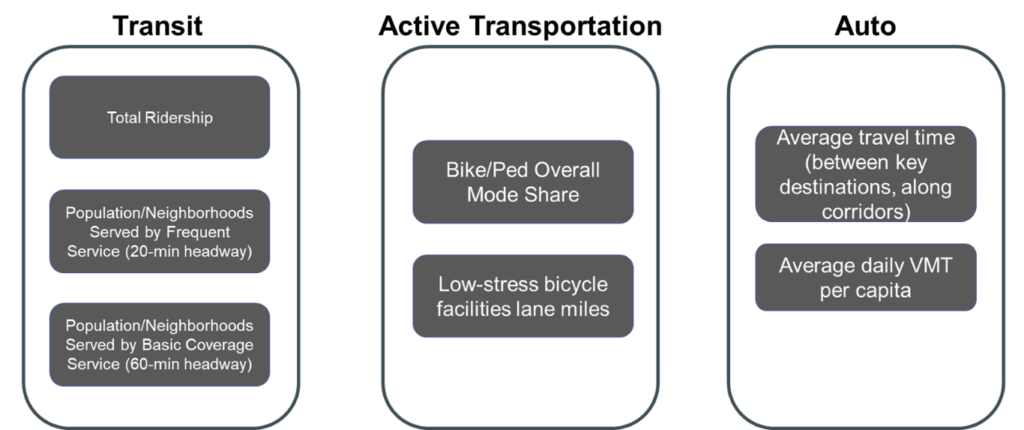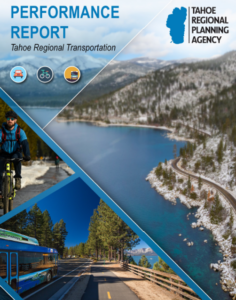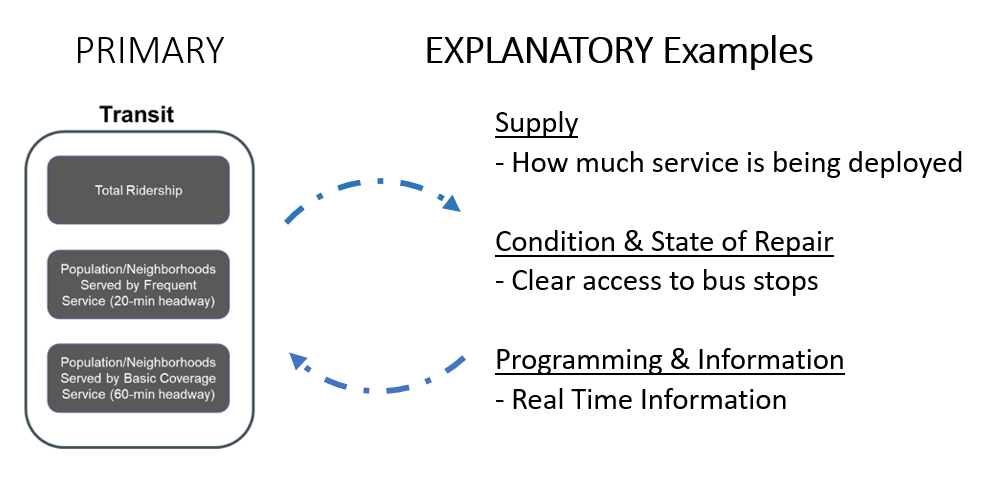Performance and Monitoring
Monitoring
TRPA measures the transportation system at Tahoe to know what is happening on roads, paths, and bus routes. Such information is critical for the agency to adapt planning initiatives, direct funding to projects and programs, respond to emerging issues, and refine projects and programs for better outcomes. It is also how TRPA continuously manages for success. To do so, TRPA collects data from a variety of sources, including surveys, U.S.Census data, “BigData,” and the TRPA Travel Demand Model. The agency uses these data, tools, and analysis to monitor specific transportation performance measures every one to four years.
Transportation Monitoring Dashboard
TRPA has been at the forefront of environmental stewardship through data-driven decision making since its inception. The performance measurement framework supports our understanding of the system’s operating effectiveness and helps to identify the projects and programs that will most effectively lead to the achievement of regional goals. Metrics and monitoring data are available through the Lake Tahoe Information Transportation Monitoring Dashboard.
Transportation Web Maps
TRPA maintains online maps of the Region’s transportation system. The maps show existing transit routes and stops, existing and proposed active transportation facilities, intersections identified for safety improvements, crash locations, electric vehicle charging stations, and corridor plan boundaries, and past, present, and future transportation projects. The following maps are currently available include the Lake Tahoe Info – EIP Project Tracker Map and Lake Tahoe Transportation System Map.
Bike Trail User Model
The Bike Trail User Model estimates bicycle and pedestrian use on shared-use paths and bike lanes at Lake Tahoe. The model is based on observed facility use, characteristics of individual facilities, and user demographics and travel behaviors. Click here for instructions on how to use the model or here for a full model demonstration.
Performance Management
Transportation Performance Management is a strategic approach that uses performance data to inform decision-making and outcomes. When implemented effectively, performance management can improve project and program delivery, inform investment decisions, and provide greater transparency and accountability. Performance-based planning defines current transportation performance levels, establishes target performance levels, and identifies strategies for achieving these targets.
Performance measures inform us if we are achieving our goals. They also assist in taking a strategic approach to make investment and policy decisions that will ultimately help us meet our regional and state goals. TRPA’s role is to monitor how the region’s transportation system is performing, develop targets that will help improve the transportation system, and track the progress in reaching these targets.
Federal Performance Measures
Since 2012, the US Department of Transportation has focused on a performance-based planning approach to our transportation systems. The Moving Ahead for Progress in the 21st Century (MAP-21) federal transportation bill for the first time established a performance and outcome-based program. The Fixing America’s Surface Transportation (FAST) Act carried this approach forward and required that Transportation Performance Management is incorporated in to plans and programs that Metropolitan Planning Organizations (MPOs) produce. States and MPOs are now required to develop performance measure targets for the following Performance Measure (PM) categories below. Please click on a category to learn more.
- PM 1 – Safety
- PM2 – Pavement and Bridges on the NHS
- PM3 – System Reliability, Freight, Congestion, and Air Quality
- Transit Asset Management Targets
Reporting Requirements
The Federal Highway Administration and Federal Transit Administration are tasked with developing and issuing guidance for each of the national performance measures. After each Final Rule is issued, each state is required to develop targets for each performance measure within one year (unless otherwise specified). MPOs are then required to either adopt the state’s targets or develop their own regionally-specific targets within six months (180 days) of the adoption of state targets. MPOs are also required to incorporate the performance measure targets in their regional transportation plan and transportation improvement programs (TIPs).
In December of 2012, the TRPA Governing Board approved the Lake Tahoe Regional Transportation Plan and Sustainable Communities Strategy (Mobility 2035). Our latest reports include: Mobility 2035: Transportation Monitoring Program Report and 2016 Bicycle & Pedestrian Monitoring Report
Coordination
MAP-21 requires that state Departments of Transportation coordinate with MPOs, local agencies, and public transportation providers when setting performance targets. MPOs, to the extent practicable, must coordinate with relevant State and public transportation providers when setting regional targets. TRPA will continue to work with Caltrans, NDOT, transit operators, and local agencies when setting targets.
TRPA Transportation Biennial Transportation Performance Reporting
Transportation monitoring has been a focus along with performance management for some time now, as shown on the Lake Tahoe Info monitoring dashboard. The TRPA Governing Board reinforced this back in 2021, along with the adoption of the 2021 RTP, updating the Regional Plan with a new VMT Standard and the Implementation Element with requirements for measuring progress and adaptively managing transportation. The new threshold standard, Transportation Sustainable Communities 1 (TSC1) includes specific VMT target
s that must be met over time and lays out an adaptive management process lead by a new Transportation Technical Advisory Committee.
In April 2021, the TRPA Governing Board adopted a new Sustainable Communities threshold category and associated VMT per-capita standard (TSC-1). Along with adoption of the new standard, the Governing Board also adopted a new goal in the Development and Implementation Priorities sub-element of the TRPA Goals and Policies (DP-5) that includes a suite of adaptive management actions to achieve and maintain the new TSC-1 standard (Regional Plan Policies).
The adaptive management fra
mework outlined by DP-5 includes:
- Establishment of a technical advisory body for transportation
- Requiring the technical advisory body to prepare and transmit to the TRPA and TMPO governing boards a regular report including past performance, findings, and recommendations that the boards must act on
- Establishing a schedule of milestones to measure progress towards the per capita VMT reduction goal
- Implementing identified adaptive management responses if scheduled milestones are not met
March 2022 the Governing Board in accordance with DP-5.1 approved the following committee members “composed of local and regional transportation project and program implementors, one representative from the environmental community and one from the general public.”
Performance Management Committee
| Placer County | City of South Lake Tahoe |
| Douglas County | El Dorado County |
| Washoe County | Carson City |
| Tahoe Transportation District | United States Forest Service; Lake Tahoe Basin Management Unit |
| Truckee North Tahoe Transportation Management Association | South Shore Transportation Management Association |
| Nevada Department of Transportation | Caltrans |
| League to Save Lake Tahoe | General Public Representative |
| Tahoe Regional Planning Agency | |
Work Plan
Phase 1: Develop Key Transportation Metrics – complete

Phase 2: Create Adaptive Management Framework – complete
Phase 3: Evaluate and Adjust – Recommendations Reports to be prepared every two years, alternating between Vehicle Miles Traveled and Recommendations report, beginning in 2022 with creation of the framework and then Regional Transportation Plan/Sustainable Communities Strategy Recommendations Report, beginning in 2024.

Meetings and Materials
- January 19, 2023 first meeting. See TRPA meetings link, under Other Meeting Materials for details.
- March 2023 – Framework Staff Report
- September 2022 – TAC Charter, Staff Report
- March 2022 – Creation of the TAC, Staff Report

